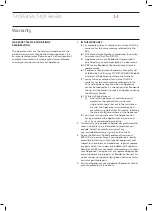
05
Instruction Manual
— It is hazardous for anyone other than an authorised service person to service this
appliance.
— In Queensland the authorised service person MUST hold a gas work authorisation for
hydrocarbon refrigerants to carry out servicing or repairs which involve the removal of
covers.
Electrical Connection
Warning!
Risk of fire and electrical shock.
— The appliance must be earthed. The refrigerator power cord has a three-pin plug
(grounded) and complies with the standard three-pin socket. NEVER cut off or remove
the third PIN of the power cord under any circumstances. After the refrigerator is installed,
plugs should be within reach to facilitate use. The power plug must be firmly contacted
with the socket, otherwise it might cause a fire.
— The refrigerator use alternating current supply which is 220V-240V, 50Hz. If the voltage
fluctuations are larger (over the scope of 187-264V), it may cause some failures, such as
the refrigerator not to start, the main control board and compressor works with abnormal
sounds, etc.
— Make sure that the electrical information on the rating plate is in compliance with the
power supply. If not, contact an electrician.
— Always use a correctly installed shockproof socket.
— Do not use multi-plug adapters and extension cables.
— Make sure there is no damage to the mains plug or the mains cable. Should the power
supply cable need to be replaced, this must be carried out by our Service Centre.
— Connect the mains plug to the mains socket only at the end of the installation. Make sure
that there is access to the mains plug after the installation. Do not connect the appliance
plug with a power connection board.
— Do not pull the mains cable to disconnect the appliance. Always pull the mains plug.
— Do not touch the mains cable or the mains plug with wet hands.
— Do not grasp and drag the power cord to pull out the refrigerator plugs. Hold the plug
firmly, and pull out the plug from the socket directly. Do not let power lines are pined by the
refrigerator or trampled by people. Be careful when the refrigerator will be removed from
walls. Do not roll or damage power lines. Do not use power lines and plugs when they are
damaged or worn out. Go to the service center which the factory assigns to replace power
lines if they were worn out or damaged.
2.3 Appliance use
Warning!
Risk of fire, explosion, electric shock or damage to the appliance.
— This appliance is intended to be used in a internal household application and/or similar
environment such as:
- A staff kitchen area of a business or office;
- Regional accommodation including hotels, motels and bed & breakfasts;
- Catering services and similar applications.
— Do not change the specification of this appliance.
— Do not sit or stand on the open door, or allow children to climb on the door.
— Do not use mechanical devices or other means to accelerate the defrosting process, other
than those recommended by manufacturer.
— Do not use or store electrical appliances inside the food storage compartments of the
appliance, unless they are of the type recommended by the manufacturer.
— The appliance has to be unplugged after use and before carrying out user maintenance on
the appliance.
— Do not store explosive substances such as aerosol cans with a flammable propellant in
this appliance.
— Do not use flammable solvent near refrigerator, so as to avoid fire.
— After the refrigerator is running, do not touch the icy surface of the freezer with hands,
particularly when hands are wet. It may cause frostbite.
— The gap between the door and and the refrigerator body is very tight to ensure a good
seal. Be careful not to insert your hands into this gap (particularly when the door is
opening or closing) in order to prevent injury to your fingers. Avoid letting children near the
refrigerator when opening and closing the doors.
— Never place bottles of beer, or soft drinks in the freezer. They may explode due to
expansion.
Safety Notes Continued


































